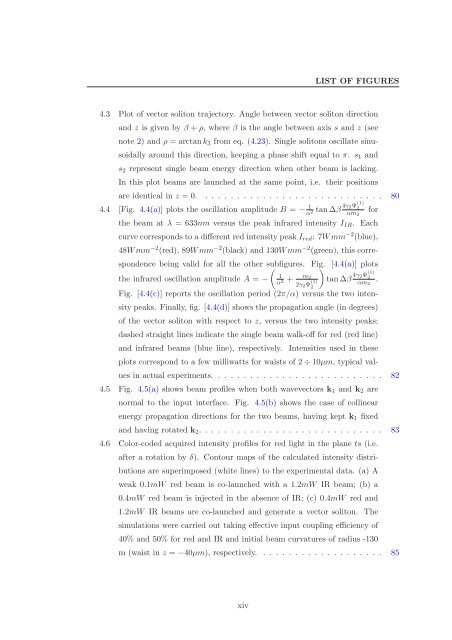Solitons in Nonlocal Media
Solitons in Nonlocal Media
Solitons in Nonlocal Media
You also want an ePaper? Increase the reach of your titles
YUMPU automatically turns print PDFs into web optimized ePapers that Google loves.
LIST OF FIGURES<br />
4.3 Plot of vector soliton trajectory. Angle between vector soliton direction<br />
and z is given by β + ρ, where β is the angle between axis s and z (see<br />
note 2) and ρ = arctank3 from eq. (4.23). S<strong>in</strong>gle solitons oscillate s<strong>in</strong>u-<br />
soidally around this direction, keep<strong>in</strong>g a phase shift equal to π. s1 and<br />
s2 represent s<strong>in</strong>gle beam energy direction when other beam is lack<strong>in</strong>g.<br />
In this plot beams are launched at the same po<strong>in</strong>t, i.e. their positions<br />
are identical <strong>in</strong> z = 0. . . . . . . . . . . . . . . . . . . . . . . . . . . . . 80<br />
4.4 [Fig. 4.4(a)] plots the oscillation amplitude B = − 1<br />
α 2 tan ∆β<br />
4γ2Ψ (1)<br />
2<br />
αm2<br />
the beam at λ = 633nm versus the peak <strong>in</strong>frared <strong>in</strong>tensity IIR. Each<br />
curve corresponds to a different red <strong>in</strong>tensity peak Ired: 7Wmm −2 (blue),<br />
48Wmm −2 (red), 89Wmm −2 (black) and 130Wmm −2 (green), this corre-<br />
spondence be<strong>in</strong>g valid for all the other subfigures. Fig. [4.4(a)] plots<br />
the <strong>in</strong>frared oscillation amplitude A = −<br />
tan ∆β<br />
1<br />
α 2 + m2<br />
2γ2Ψ (1)<br />
2<br />
for<br />
(1)<br />
4γ2Ψ 2 . αm2<br />
Fig. [4.4(c)] reports the oscillation period (2π/α) versus the two <strong>in</strong>ten-<br />
sity peaks. F<strong>in</strong>ally, fig. [4.4(d)] shows the propagation angle (<strong>in</strong> degrees)<br />
of the vector soliton with respect to z, versus the two <strong>in</strong>tensity peaks;<br />
dashed straight l<strong>in</strong>es <strong>in</strong>dicate the s<strong>in</strong>gle beam walk-off for red (red l<strong>in</strong>e)<br />
and <strong>in</strong>frared beams (blue l<strong>in</strong>e), respectively. Intensities used <strong>in</strong> these<br />
plots correspond to a few milliwatts for waists of 2 ÷ 10µm, typical val-<br />
ues <strong>in</strong> actual experiments. . . . . . . . . . . . . . . . . . . . . . . . . . . 82<br />
4.5 Fig. 4.5(a) shows beam profiles when both wavevectors k1 and k2 are<br />
normal to the <strong>in</strong>put <strong>in</strong>terface. Fig. 4.5(b) shows the case of coll<strong>in</strong>ear<br />
energy propagation directions for the two beams, hav<strong>in</strong>g kept k1 fixed<br />
and hav<strong>in</strong>g rotated k2. . . . . . . . . . . . . . . . . . . . . . . . . . . . . 83<br />
4.6 Color-coded acquired <strong>in</strong>tensity profiles for red light <strong>in</strong> the plane ts (i.e.<br />
after a rotation by δ). Contour maps of the calculated <strong>in</strong>tensity distri-<br />
butions are superimposed (white l<strong>in</strong>es) to the experimental data. (a) A<br />
weak 0.1mW red beam is co-launched with a 1.2mW IR beam; (b) a<br />
0.4mW red beam is <strong>in</strong>jected <strong>in</strong> the absence of IR; (c) 0.4mW red and<br />
1.2mW IR beams are co-launched and generate a vector soliton. The<br />
simulations were carried out tak<strong>in</strong>g effective <strong>in</strong>put coupl<strong>in</strong>g efficiency of<br />
40% and 50% for red and IR and <strong>in</strong>itial beam curvatures of radius -130<br />
m (waist <strong>in</strong> z = −40µm), respectively. . . . . . . . . . . . . . . . . . . . 85<br />
xiv
















